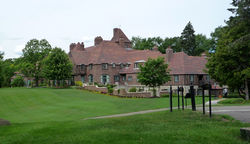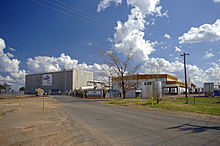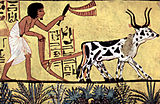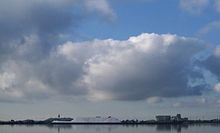- Cargill
-
For other uses, see Cargill (disambiguation) and Kargil (disambiguation).
Cargill, Inc. 
Type Private Industry Agriculture Founded 1865 Headquarters Minnetonka, Minnesota, US Area served Worldwide Key people Gregory R. Page (CEO) Products Crop and livestock, food, Health & Pharmaceutical, Industrial & Financial & Risk Management, Electricity and gas Revenue  $119.5 billion (2011)
$119.5 billion (2011)Operating income  $4.6 billion (2011)
$4.6 billion (2011)Net income  $4.24 billion (2011)
$4.24 billion (2011)Employees 131,000 (2011) Website Cargill.com Cargill, Incorporated is a privately held, multinational corporation based in Minnetonka, Minnesota. Founded in 1865, it is now the largest privately held corporation in the United States in terms of revenue.[1] If it were a public company, it would rank, as of 2011, number 13 on the Fortune 500, behind AT&T and ahead of JP Morgan Chase.[2] Some of Cargill's major businesses are trading, purchasing and distributing grain and other agricultural commodities; trading in energy, steel and transport; the manufacture of livestock and feed; producing food ingredients such as starch and glucose syrup, vegetable oils and fats for application in processed foods and industrial use. Cargill also operates a large financial services arm, which manages financial risks in the commodity markets for the company. In 2003, it split off a portion of its financial operations into a hedge fund called Black River Asset Management, with about $10 billion of assets and liabilities.[3] It owned 2/3 of the shares of The Mosaic Company (sold off in 2011), one of the world's leading producers and marketers of concentrated phosphate and potash crop nutrients.
Cargill declared revenues of $116.6 billion and earnings of $3.33 billion in the 2009 fiscal year.[4] Employing over 130,000 employees in 66 countries,[2] it is responsible for 25% of all United States grain exports. The company also supplies about 22% of the US domestic meat market, exporting more product from Argentina than any other company and is the largest poultry producer in Thailand. All of the eggs used in McDonald's restaurants in the US pass through Cargill's plants. It is the only producer of Alberger process salt in the US, which is highly prized in the fast-food and prepared food industries.
Cargill remains a family-owned business, as descendants of the founder (from the Cargill and MacMillan families) own over 85% of the company.[5] As a result, most of its growth has been due to reinvestment of the company's own earnings rather than public financing. Gregory R. Page, who is not part of either the Cargill or MacMillan families, is the chief executive officer of Cargill. He succeeded former CEO Warren Staley in mid-2007, as Staley hit Cargill's mandatory retirement age of 65.
Contents
History
 The Cargill Lake Office, occupying the former Rufus Rand mansion on the main corporate campus in Minnetonka, houses the company's top executives.[6]
The Cargill Lake Office, occupying the former Rufus Rand mansion on the main corporate campus in Minnetonka, houses the company's top executives.[6]
Cargill was founded in 1865 by William W. Cargill when he bought a grain flat house in Conover, Iowa. A year later William was joined by his brother, Sam, forming W.W. Cargill and Brother. Together they built grain flat houses and opened a lumberyard. In 1875, Cargill moved to La Crosse, Wisconsin, and brother, James, joined the family business. The city of La Crosse was strategically located at the junction of the Milwaukee Road railroad and the Southern Minnesota Division. Sam Cargill left La Crosse in 1887 and moved to Minneapolis to manage the office there, which was identified as an important emerging grain center. Three years later the Minneapolis operation incorporated under Cargill Elevator Co., years after that the La Crosse operation was incorporated under W.W. Cargill Company of La Crosse, Wisconsin. In 1898, John H. MacMillan, Sr., and his brother, Daniel, began working for W.W. Cargill. John MacMillan then married William Cargill's eldest daughter, Edna. Upon Sam Cargill's death in 1903, William Cargill became the sole owner of the La Crosse office. John MacMillan was named as general manager of Cargill Elevator Company and moved his family to Minneapolis. William Cargill died in 1909, creating a fiscal crisis for the company. MacMillan worked to resolve the credit issues and to force his brother-in-law, William S., out of the company. The current owners are descended from John MacMillan's two sons, John H. MacMillan, Jr., and Cargill MacMillan, Sr., and his youngest brother-in-law, Austen S. Cargill I.
John MacMillan ran the company until his retirement in 1936. Under his leadership Cargill grew several fold, expanding out of the Midwest by opening its first East coast offices, in New York, in 1923, and the first Canadian, European and Latin American offices in 1928, 1929 and 1930. During this time, Cargill saw both record profits and major cash crunches. The first of these crises was the debt left by the death of W.W. Cargill. The company issued $2.25 million in Gold Notes, backed by Cargill stock to pay off its creditors. The Gold Notes were due in 1917, but thanks to record grain prices caused by World War I all debts were paid back in 1915. As World War I continued into 1917, Cargill made record earnings and faced criticisms of war profiteering. Four years later, as a fallout from the financial crash of 1920, Cargill posted its first loss.
One of the company's biggest criticisms has been its perceived arrogance. See, for example, Brewster Kneen in the Ecologist and also Greg Muttitt in the same journal. The MacMillans' aggressive management style led to a decades long feud with the Chicago Board of Trade. The feud began in 1934, when the Board denied membership to Cargill. The US government overturned the Board's ruling and forced it to accept Cargill as a member. The 1936 corn crop failed and with the 1937 crop unavailable until October, the Chicago Board of Trade ordered Cargill to sell some of its corn. Cargill refused to comply. The US Commodity Exchange Authority and Chicago Board of Trade accused Cargill of trying to corner the corn market. In 1938, the Chicago Board suspended Cargill and three of its officers from the trading floor. When the Board lifted its suspension a few years later, Cargill refused to rejoin. Cargill instead traded through independent traders. In 1962, Cargill did rejoin the Chicago Board of Trade, two years after the death of John MacMillan, Jr. During World War II, MacMillan, Jr., continued to expand the company, which boomed as it stored and transported grain and built ships for the United States Navy.[6]
In 1960, Erwin Kelm became the first non-family chief executive. Aiming expansion downstream, he led the company into milling, starches and syrups. As the company got larger, it developed among the market intelligence of any in the world as it coordinated its commodities trading, processing, freight, shipping and futures businesses. In the decades before email, the company relied on its own telex-based system to connect the company.[6]
When the Soviet Union entered the grain markets in the 1970s, demand grew to unprecedented levels to the benefit of Cargill. When Whitney MacMillan, nephew of John, Jr., took over the company from Kelm in 1976, revenue approached $30 billion. US government put pressure on big grain exporters on allegations of manipulating the market, and Cargill was a major target; however it emerged without any major changes.[6]
Tensions arose with the company's private shareholders, as Cargill typically put 80% of earnings back into the business. By the early 1990s, members of the Cargill and MacMillan families became upset that their shares in the company were only giving back mediocre dividends. Demands rose for an initial public offering to turn the company public. The company responded with an employee stock ownership plan, and in 1993 reportedly purchased 17% of the firm for $730 million from 72 Cargills and MacMillans. It used that stake to begin the employee stock plan. The company's board of directors was reorganized to reduce the number of relatives to six, alongside six independents and five managers.[6]
Ernest Micek took over as chief executive in August 1995. Cargill underwent turmoil in the following years as its financial unit lost hundreds of millions of dollars in 1998 when Russia defaulted on debt and developing countries began to have financial issues. The commodities and ingredients business, which was 75% of Cargill's total revenue, suffered from the 1997 Asian Financial Crisis.[6] Revenues fell by double-digit percentages for two years in a row: from $55.7 billion in 1997 to $51.4 billion in 1998 and $45.7 billion in 1999, while net income fell from $814 million in 1997 to $468 million in 1998, and $220 million in 1999.[5] By 1999, the company had $4 billion in debt. After a reduction in previously strong bond credit rating, Micek announced he would step down a year early.[6]
Warren Staley became chief executive and continued expanding the company and it rebounded. By 2002, Cargill had over $50 billion in annual sales, twice the amount of its closest rival, Archer Daniels Midland, and had 97,000 employees running more than 1,000 production sites and out of 59 countries.[6] On June 1, 2007, Staley was succeeded by Gregory R. Page.
Cargill's quarterly profits crossed $1 billion for the first time during the quarter ending on February 29, 2008 ($1.03 billion); the 86% rise was credited to global food shortages and the expanding biofuels industry that, in turn, caused a rise in demand for Cargill's core areas of agricultural commodities and technology.[7][8][9]
In October 2011, the U.S. Justice Department announced that a biotech specialist at Cargill had pleaded guiltly to stealing information from Cargill and Dow AgroSciences. Kexue Huang, a Chinese national, was discovered to be passing trade secrets back to China.[10]
Political and economic views
Cargill is an active proponent of free trade policies. It lobbied for China's membership in WTO and for increased trade with Cuba and Brazil. Cargill strongly supports neo-liberal economic principles as part of its business model. Firstly, Cargill fights for lesser trade barriers in countries where Cargill does have a business presence and it will lower prices on Cargill's products, so as to increase the volume of products sold. Secondly, decreases in the cost of food in developing countries theoretically results indirectly to higher income per capita however, lower income is returned to local farmers. Cargill benefits from increases in consumer income, because better-paid consumers become inclined to eat a diet higher in wheat, protein, vegetable oil, and processed foods. This improves opportunities for Cargill to sell its products. Cargill's economists have reasoned that this is true of the lower-income countries in particular. As a developing country grows in mean per-capita income, Cargill expects the greatest profit growth from its businesses in that country.
Countries of operation
Asia Pacific
 Cargill Beef Australia located in Wagga Wagga, New South Wales, Australia
Cargill Beef Australia located in Wagga Wagga, New South Wales, Australia
Australia, China, India, Indonesia, Japan, Malaysia, Pakistan, Philippines, South Korea, Singapore, Sri Lanka, Taiwan, Thailand, Vietnam
Africa
Cameroon, Cote d'Ivoire, Egypt, Ghana, Kenya, Malawi, Morocco, Nigeria, South Africa, Tanzania, Zimbabwe, Zambia
Central America and the Caribbean
Bonaire, Costa Rica, Dominican Republic, Guatemala, Honduras, Nicaragua
Europe
Austria, Belgium, Denmark, Finland, France, Germany, Greece, Hungary, Ireland, Italy, Netherlands, Poland, Portugal, Romania, Russian Federation, Spain, Sweden, Switzerland, Turkey, Ukraine, United Kingdom
Middle East
North America
Canada, Mexico, United States of America
South America
Argentina, Bolivia, Brazil, Chile, Colombia, Paraguay, Peru, Uruguay, Venezuela
Sponsorships
Since 2009/10 Cargill have been the chief shirt sponsors of Hereford United F.C.. A fourth tier English football team.
Criticism
Main article: Criticisms of CargillCargill has been subject to numerous criticisms over a number of topics including environmental issues, contamination and humans rights abuses. Further, as a private company, Cargill is not required to release the same amount of information as a publicly traded company and, as a business practice, keeps a relatively low profile.[5][6] The company received praise from Temple Grandin, well-known professor of animal science at Colorado State University, for allowing the Oprah Show to film the inside of a beef slaughter plant in Colorado.[11]
Human rights abuses
In 2005, the International Labor Rights Fund filed suit against Cargill, Nestlé and Archer Daniels Midland in federal court on behalf of children who were trafficked from Mali into the Ivory Coast and forced to work 12 to 14 hours a day with no pay, little food and sleep, and frequent physical abuse on cocoa bean plantations.[12]
Cargill is a major buyer of cotton in Uzbekistan, despite its industry's prevalence of uncompensated workers and possible human rights abuses, and admissions made by two representatives that the company is aware of the possible use of child labor in the production of its crops. Their concerns have been public since 2005, but no action has been taken regarding labor violations existent in their Uzbek operations.[13][14]
Food contamination
In 1970, Cargill sold 63,000 tons of seed grain to Basra, Iraq treated with methylmercury, a practice banned in most Western countries. Though intended for agricultural use, and not for human or animal consumption, some recipients used it as food, as the only printed warnings about the poison were written in English and Spanish, intended as warnings for American dock workers. This led to the deaths of 93 people.[15]
In October 2007, Cargill announced the recall of nearly 850,000 frozen beef patties produced at its packing plant in Butler, Wisconsin. The patties were suspected of being contaminated with E. coli.[16] The beef was sold mainly at Walmart and Sam's Club stores.
In March 2009, the Australian Quarantine and Inspection Service (AQIS) temporarily suspended Cargill Australia's license to export meat to Japan and the US, after E. coli was detected in Cargill's export containers from its Wagga Wagga plant. In late April 2009, AQIS lifted Cargill Australia's suspension on its export licence.[17]
In August 2011, the USDA and Cargill jointly announced the recall of 36 million pounds of ground turkey produced at Cargill's Springdale, Arkansas plant due to salmonella fears. The meat recalled was produced from February, 20 to August 2. The Centers for Disease Control and Prevention announced that the particular strain of salmonella found was resistant to commonly prescribed antibiotics. At this time one death and seventy-six illnesses from twenty-six states have been reported. Some twenty-five types of ground turkey produced under various brand names are impacted, and all of the packages in question contain the code "Est. P-963." http://www.fsis.usda.gov/News_&_Events/Recall_060_2011_Release/index.asp
Deforestation
 Cargill in Santarém, Brazil
Cargill in Santarém, Brazil
In 2003, Cargill completed a port for processing soya in Santarém in the Amazon region of Brazil, dramatically increasing soya production in the area, and according to Greenpeace, speeding up deforestation of local rain forest.[18] In February 2006, the federal courts in Brazil gave Cargill six months to complete an environmental assessment (EA). Initially supported by job-seeking locals, public opinion turned against the port as jobs have not appeared. In July 2006, the federal prosecutor indicated they were close to shutting down the port.[19] Greenpeace took its campaign to major food retailers and quickly won agreement from McDonald's along with UK-retailers Asda, Waitrose and Marks & Spencer to stop buying meat raised on Amazonian soya. These retailers in turn put pressure on Cargill and Archer Daniels Midland, Bunge, André Maggi Group and Dreyfus to prove their soya was not grown on recently deforested land in the Amazon. In July 2006, Cargill reportedly joined other soy businesses in Brazil in a two-year moratorium on the purchase of soybeans from newly deforested land.[20] [21]
Notes
See also
- Cargill family
- Alberger process
- Margaret Anne Cargill
References
- ^ Forbes.com - The Largest Private Companies
- ^ http://money.cnn.com/magazines/fortune/fortune500/2011/full_list/index.html
- ^ UKdata.com
- ^ Cargill's Five-year financial summary
- ^ a b c Caroline Daniel, Château Cargill throws open its halls, Financial Times, February 26, 2004. Retrieved June 15, 2009.
- ^ a b c d e f g h i Neil Weinberg with Brandon Copple, Going Against The Grain, Forbes.com, November 25, 2002. Retrieved June 12, 2009.
- ^ Matt McKinney, At $471,611 an hour, Cargill posts fine quarter, Star Tribune, April 15, 2008.
- ^ Kneen, Brewster (2003). "Size is Everything". The Ecologist 33 (3): 48–51.
- ^ Muttitt, Greg (2001). "Control Freaks". The Ecologist 31 (2): 52.
- ^ Tom Webb (2011-10-20). "A Cargill scientist, and a spy for China". Twin Cities Pioneer Press. http://www.twincities.com/ci_19151757.
- ^ Temple Grandin (2011-05-16). "Open the Barn Doors". http://www.nytimes.com/roomfordebate/2011/05/10/preventing-cruelty-to-farm-animals/open-the-doors-to-factory-farms.
- ^ ADM, Nestle & Cargill Sued for Sourcing Cocoa Beans for Chocolate from Slave Labor Plantations in Africa
- ^ Ethical Corporation: Europe - Uzbekistan cotton – A thread of hope in the retail fabric
- ^ "The Curse of Cotton: Central Asia's Destructive Monoculture", International Crisis Group, February 28, 2005, pages 39. http://www.crisisgroup.org/home/index.cfm?id=3294 see also pages 2.
- ^ Broehl, Wayne G., Jr. (1998) Cargill: Going Global. University Press of New. England, Hanover, New Hampshire. Pages 167-171,
- ^ Wisconsin Firm Recalls Ground Beef Products Due to Possible E. coli O157:H7 Contamination
- ^ "Cargill exports beef - tracking system at abattoir". Meat International. 2009-04-28. http://www.meatinternational.com/news/slaughtering/australia-cargill-exports-beef-tracking-system-at-abattoir-id1329.html. Retrieved 2009-04-29.
- ^ Feature story - December 12, 2003 (2003-12-12). "Soya blazes a trail through the Amazon | Greenpeace International". Greenpeace.org. http://www.greenpeace.org/international/news/soya-blazes-through-the-amazon. Retrieved 2010-08-17.
- ^ Astor, Michael (2006-07-19). "Cargill finds resistance by environmentalists | Business | Chron.com - Houston Chronicle". Chron.com. http://www.chron.com/disp/story.mpl/business/4058727.html. Retrieved 2010-08-17.
- ^ [1][dead link]
- ^ http://www.greenpeace.org.br/amazonia/pdf/cargill.pdf
External links
Minnesota-based corporations Fortune 500 Corporations (by size) UnitedHealth Group · Target · SuperValu · Best Buy · Travelers · 3M · U.S. Bancorp · CHS · General Mills · Medtronic · Xcel Energy · Land O'Lakes · Ameriprise Financial · C. H. Robinson Worldwide · Hormel · Thrivent Financial for Lutherans · The Mosaic Company · Ecolab · St Jude MedicalFortune 1000 Corporations (by size) Companies listed above, plus: PepsiAmericas · Nash Finch · Pentair · Alliant Techsystems · Valspar · Patterson Companies · Securian Financial Group · Regis · Polaris Industries · Toro · Deluxe · Donaldson · Fastenal · H.B. Fuller · Federated Mutual Insurance Company · CeridianMajor non-public or externally
owned corporations (alphabetically)Agriculture General 
History Types Aquaculture · Dairy farming · Grazing · Hydroponics · Livestock · Pig farming · Orchards · Poultry farming · Sheep husbandryCategories Agriculture by country · Agriculture companies · Biotechnology · Livestock · Meat industry · Poultry farmingPortal · CategoryCategories:- Companies established in 1865
- Cargill
- Privately held companies based in Minnesota
- Agriculture companies of the United States
- Food production companies of the United States
- Companies based in Minnesota
- Family businesses
- Multinational food companies
- Wholesalers of the United States
- Flavor companies
- Starch companies
Wikimedia Foundation. 2010.

